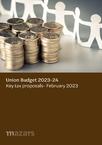Union Budget 2023-24 I Key tax proposals
Finance Minister, Smt. Nirmala Sitharaman, presented the budget around seven key pillars, namely:
- Inclusive development
- Reaching the last mile
- Infrastructure and investment
- Unleashing the potential
- Green growth
- Youth power
- Financial sector
Facilitating ample opportunities for all citizens, especially the youth, with a strong impetus on skill development and job creation has been of prime focus. The proposals particularly target the development of children & adolescents, women, farmers, OBCs, Scheduled Castes and Scheduled Tribes, differently abled people, as well as all other economically weaker and underprivileged sections with the Sabka Saath Sabka Vikas policy.
Meanwhile, initiatives are underway to aid MSMEs in the next leg of their development. The revamped credit guarantee scheme for MSMEs announced last year is set to take effect from FY24, with an infusion of INR 9,000 crore in the corpus. This will allow for an additional INR 2 lakh crore in collateral-free guaranteed credit, reducing the cost of credit by approximately 1%. Apart from this, ‘Vivad se Vishwas I’ aims to bring relief to MSMEs for failure to execute contracts during COVID-19, enabling the return of 95% of the forfeited amount related to bid or performance security. The ability to pass by all pandemic-related hardship will enable MSMEs a level-playing field, which is critical to fuel domestic manufacturing required for “Atmanirbhar Bharat.”
In the education sector, the establishment of a national digital library is a highly ambitious initiative aimed to address the issue of resource scarcity and promote the dissemination of knowledge in key areas such as technology and financial literacy. The library will provide the youth with the opportunity to explore new topics and expand their horizons, as well as allow them to stay informed on cutting-edge gateways and other relevant fields. It can bridge India’s skill gap and put the local youth on par with global counterparts, which is critical given the growing integration of new-age accelerators such as artificial intelligence, machine learning and robotics across industries.
Realizing the importance of data as a valuable resource for driving innovation, research, and economic growth and harnessing the full potential of this resource, the government has announced the establishment of a National Data Governance Policy. It will play a critical role in shaping the future of India's data-driven economy by enabling startups and academia to access anonymized data and drive innovation and research.
Sustainability has been a key topic this year, being not just one of the seven pillars of the budget but a critical leg of growth addressed in almost every industry. The government is moving toward net zero carbon emissions by 2070, which includes taking significant steps to reduce the carbon intensity of the economy, meet clean energy targets, and create large-scale green job opportunities.
The budget has provided INR 35,000 crore for priority capital investment toward energy transition along with an outlay of INR 19,700 crore for the National Green Hydrogen Mission to facilitate the transition of the economy to low carbon intensity and reduce dependence on fossil fuel imports.
In the mobility sector, the government has announced policies to support the growth of electric vehicles and clean energy solutions. This includes reducing taxes on machinery needed to produce lithium-ion batteries and providing incentives for the purchase of electric two-wheelers.
Having said that, the biggest limelight of joy this budget for the common man has been the revision of personal income tax slabs, rebates and exemptions under the new tax regime. The income tax rebate limit has been raised to INR 7 lakh, the tax exemption limit has been raised to INR 3 lakh and the tax slabs have been reduced by one. Providing people with lower tax burdens will enable greater disposable incomes that can spur greater saving, investment, and steady consumption amid a volatile global economy. This can enable India to curb major recessionary pressures from the global realm and ensure the return of full-scale operations.
In terms of the way forward, the capital investment outlay increased by 33% to INR 10 lakh crores, accounting for 3.3% of the GDP to support the government’s efforts toward growth potential and job creation, crowd-in private investment, and provide a cushion against global headwinds. This heightened spending is crucial as it involves significant investment in the development of infrastructure and logistical nets.
The revised estimate of the fiscal deficit for FY23 is 6.4% of GDP, adhering to the budget estimate. Meanwhile, for FY24, the fiscal deficit is estimated to be 5.9% of GDP, gearing toward the 4.5% target by FY26.
In totality, this budget has set in many new groundings for India@100, paving the blueprint for inclusive growth in the coming years and spearheading progress in a range of milestones.


